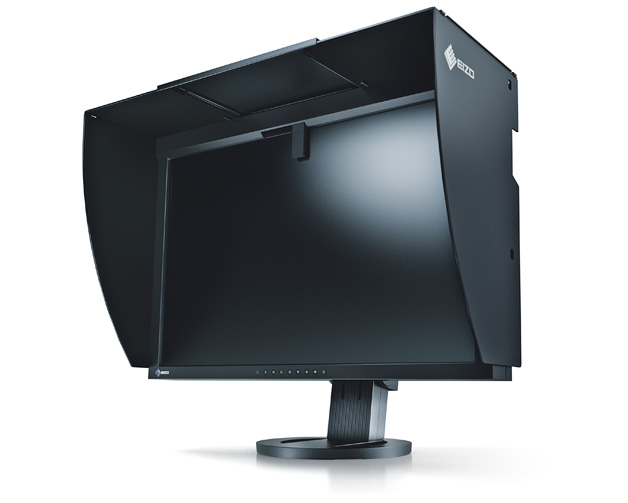Review: EIZO ColorEdge CG245W
My first serious computer monitor was a LaCie Electron Blue IV, an incredibly heavy, blue beast. It served me well for many years, until recently. It can no longer reach the desired brightness, so I had to start looking for an alternative.
At the time when I bought the massive LaCie CRT screen, it was one of the best monitors around. It certainly wasn’t the cool way to go – that would have been the flat screens – but if you wanted to see true, solid blacks instead of mere dark grays, a CRT screen was your only option. LCD monitors were regarded as lacking the color accuracy required for photography professionals, and if you wanted to get true black and high contrast, an old school CRT monitor it was.

My old set up with the LaCie ElectronBlue IV. The device on the left is my DroboPro.
If you care about your images, you need to care about your monitor. All too often I hear about photographers that spend thousands of dollars on cameras and lenses, and almost like an afterthought, they buy a third rate display that isn’t capable of correctly showing the images they’ve captured.
If you want to fully appreciate all the colors and tones of your images, you need a good monitor, just like you need a good camera and good lenses.
But that’s not all. If you want to make sure that what you see on your screen is actually how things are supposed to look, and how others will see your images, you also need to calibrate your screen. If you’re working on an uncalibrated screen, your digital image won’t reproduce faithfully in print, and they’ll also look different when viewed on other displays.
From early on I’ve always been aware of the importance of a calibrated monitor, so I bought the best hardware calibration device available at that time: the i1 Monitor by Gretach-Macbeth (now discontinued). It performed flawlessly, although the whole procedure was always a bit tedious as it involved attaching the device to the center of the screen with a suction cup, and fiddling around with the buttons on the display itself. After 15 minutes or so the calibration process was finished, and it’s always a reassuring feeling knowing that what you’re seeing on your screen is exactly what you’re supposed to see.
Over the years, things have changed considerably. LCD monitors have become the mainstream choice for photographers worldwide, and CRT displays are a thing of the past. But with so many manufacturers and so many different screens – what is the right choice?
Making the right choice
There are basically three kinds of LCD panels: TN, VA and IPS.
VA stands for Vertical Alignment, TN stands for Twisted Nematic, while IPS stands for In-Plane Switching. I won’t start speaking super technically here, but these technologies handle the way the liquid crystals move differently, resulting in different performance. Probably the biggest difference between the three, from the buyer’s perspective, is the price. TN displays are much cheaper compared to VA and IPS displays. Part of the reason of the higher price is the doubling of the number of transistors per pixel in displays, which uses two transistors.
If price is not an issue, then VA and IPS are the sure winners. VA and IPS displays do not suffer from color limitation problems, while many TN panels have limited color depth like 6-bit. To achieve better color reproduction, TN displays for instance use frame rate control and dithering but this can affect the sharpness of the image. VA and IPS displays can recreate a wider variation of colors without the use of dithering and is generally the desired technology for people who extensively work with digital imaging.
Another difference is the viewing angle. IPS displays have a very wide viewing angle and you can view the display from a very slanted angle while the image still retains its colors and you can still make out the figures on the screen. VA and TN displays, when viewed at an angle, begin to suffer from loss of color. The image becomes washed out, as if you are viewing the image through thick smoke. Furthermore, IPS technology is more energy efficient and environmental friendly. For me the choice was obvious: IPS.
The EIZO ColorEdge CG245W
After doing some serious research, I ended up choosing the EIZO ColorEdge CG245W.
EIZO? Who are EIZO?
Back in 2003 the EIZO ColorEdge series was the world’s first line of LCD monitors specifically targeted at graphics professionals. One year later, EIZO introduced the world’s first LCD monitor capable of reproducing the Adobe RGB color space. The image quality, long-term reliability, and innovative features of EIZO monitors have made them the products of choice for many photography professionals throughout the world.
While outsourcing production is now common practice in the monitor industry, EIZO continues to manufacture its products the same way it has throughout its over 40 year history — with its own staff at its own factories. This allows EIZO to keep close control over production quality and offer the industry’s only 5-year manufacturer’s limited warranty.
If you say color accuracy, you say EIZO.
The ColorEdge CG245W is a 24.1″ (61 cm) LCD display, using a 1920×1200 IPS widescreen panel. It is also the world’s first self-calibrating monitor – nice! I wanted a screen slightly larger than my old CRT, while still being able to keep my second monitor next to it for all my Photoshop palettes. I know, with a larger screen you can keep all your palettes neatly organized on the side, but I prefer to keep my main monitor as clean as possible.
Specs: http://www.eizo.com/global/iblick/spec/?id=CG245W
Unpacking
The first thing I noticed when the box was delivered, was the weight. Moving my old CRT screen took half a football team, but this box was anything but heavy.
 |
|
The box. No need to call your chiropractor. |
Opening the main container you have a long, flat box containing the instructions, a disc with the manual and software and the sections of the shading hood (for shielding the display from stray light and keeping image color consistent) for either horizontal or vertical monitor setup. A monitor cleaning kit is also included.
Getting the display out of the box was easy. The display itself was neatly wrapped in protective material.
 |
|
Protective wrapper against damage during transportation. |
Connecting the screen to my MacPro was as simple as any other device. Plug in the power cord and connect the USB cable to the computer, and voila. It was nice to see that when I turned on the computer, my desktop was immediately shown full screen, exactly filling the entire screen from edge to edge. With the LaCie this was definitely not the case and I had to spend quite some time fiddling with small buttons to adjust the screen before it would finally fill the entire space available.
And boy, does this screen look good!
The Screen
The design is simple, just the way I like it. There is a small border around the screen that houses the calibration device in the top bezel, while the bottom bezel features some small backlit menu buttons. You can dim these buttons if you prefer not to see them.
 |
|
Simple and elegant design. If you like jigsaw puzzles, then you’ll love assembling the hood. |
I ended up not using the supplied hood, because my whole set up is in a corner of my room, with no stray light coming from either side. Also, it would block part of the view of my secondary monitor, which I use for my palettes.
 |
|
Backlit buttons at the bottom of the screen have 7 brightness levels and an off function. |
Another nice feature that I was not used to, is the ability to adjust the height of the screen via the monitor’s “FlexStand”. The bearing-less design of the FlexStand requires very little force to make height adjustments.
 |
|
The ColorEdge CG245W comes with a FlexStand that offers tilt, swivel, |
At the back of the screen there are two DVI-I inputs that accept both digital and analogue signals, and a single DisplayPort (digital) input. DisplayPort is your best choice if you want to make use of the 10-bit simultaneous display.* In 10-bit more than 1 billion colors are shown simultaneously, which is a whopping 64 times greater than the 16.7 million colors of a 8-bit display, and gives you much smoother color gradations. DisplayPort transmits both video and audio signals.
*Note: A graphics board and software that support 10-bit output are also necessary for 10-bit display.
On the upper left of the monitor you can find two USB 2.0 ports. I mainly use these for quick access to USB sticks and my travel backup drives.
Most of the screens you see today are of the glossy kind – both my MacBook Pro and my iPhone feature these glossy screens. They’re great for vivid colors and rich black tones with high contrast ratios, but they also suffer from an incredible amount of reflections. I’m therefore happy that the ColorEdge CG245W uses a non-glare LCD. It shows 98% of the Adobe RGB (1998) color space, perfect for imaging professionals, and it has an excellent viewing angle.
You can tell that EIZO takes color accuracy very seriously indeed. Each unit is calibrated individually at their factory, and they include an Adjustment Certificate, Setup Guide and Quick Reference document with each monitor.
 |
|
The Adjustment Certificate (Uniformity Data Sheet) that was taped to my monitor. |
Software
The included EIZO Utility Disk contains a couple of software applications. Most important are the ColorNavigator Agent and ColorNavigator.
The ColorNavigator Agent is simply an icon in your dock that changes from blue to red when the number of hours between calibrations that you have specified has passed. By right clicking on the icon you can choose directly from any of your saved profiles.
To actually calibrate the monitor, you have to use the ColorNavigator software.
I previously used the Eye-One Match software, and although that was very easy to work with, ColorNavigator proved even simpler.
Calibration
The ColorEdge CG245W features a unique built-in calibration sensor that is housed in the top bezel of the monitor. This sensor is about the size of a USB stick, and it swings down over the center top of the screen when calibration starts. No need for third-party calibration devices anymore, it’s all included with the ColorEdge CG245W.
 |
|
When starting the calibration procedure, the built-in calibration device swings down. |
The ColorNavigator software makes calibration a real breeze. When you open ColorNavigator, a window appears asking you to select the calibrating device. The built-in calibrator is simply called ‘Built-In’ and it appears as the default choice.
After hitting ok, the second window appears. When opening the software for the first time, you have two choices: a profile for photography and graphic design, and a profile for printing. Choose one and click next.
 |
|
Apart from using the two factory profiles, you can also add your own profiles. |
The third screen offers some last minute reminders before the calibration process starts. Hit proceed and calibration begins.

The whole process took only a couple of minutes. At the end of the procedure another window appears, showing the results of your calibration. Simply save the profile, and that’s it. Your new ICC profile is instantly integrated into a ColorSync managed workflow. It really couldn’t be any simpler.
Or could it?
Well, one of the really cool things this monitor can do, is self-calibration. By using the OSD menu, you can schedule the ColorEdge CG245W to self-calibrate at a specific time and at specific intervals. You can even schedule the calibration to happen during the night, when your computer is shut down and you’re vast asleep – pretty cool!
Conclusion
The EIZO ColorEdge CG245W is a high-end monitor for imaging professionals and all people that take color seriously. The design is great, installation and operation is simple, the screen is razor sharp and evenly lit, colors look stunning, and the calibration couldn’t be easier. No cons then? A few. This monitor isn’t cheap, but you get what you pay for. The User’s Manual could be improved and at times the writing is confusing. I tried the Dutch version for a minute, but that didn’t help either. Luckily, you don’t really need the manual to get things to work. Once you get it to work, the calibration process works exactly the way that I described above. Fast and simple.
My final nit is a peculiar one. I noticed there is a difference between how my images look in a color-profiled environment such as Photoshop and Lightroom, and an environment that doesn’t use color profiles, such as internet browsers. When preparing images for the web, I always convert them to sRGB to compensate for the fact that web browsers don’t display Adobe RGB very well. The conversion to sRGB usually does the trick. On this monitor however my images look exactly how they should in a color profile environment, but they look warmer and more saturated in web browsers etc. I have contacted EIZO about this, and apparently this is the result of the monitor simply being too good – it shows much more color information than the average monitor.
I would never have thought that you can have a monitor that is too good, and I must admit that it is somewhat annoying. As a work around I have created another profile in ColorNavigator: sRGB. When viewing images outside of my color profile environment, I switch to the sRGB profile using the ColorNavigator Agent.
 |
|
My new set up with the EIZO ColorEdge CG245W. |
As a professional photographer though, the thing that counts more than anything else is quality. The ColorEdge CG245W is an excellent screen and it makes working on my images a real joy. Add to that the ease of use and the self-calibration, and it’s clear I made the right choice.


